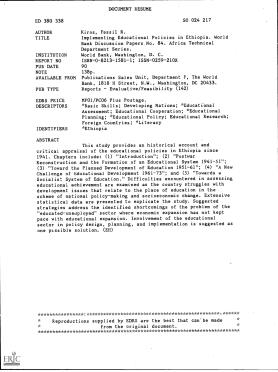education policies in Ethiopia
education policies in Ethiopia
The purpose of this paper is to provide an historical account and a critical appraisal of educational policies in Ethiopia since 1941. The study, if lacking in as much detail as might have been desired, has placed in perspective the educational performance of Ethiopia during a period of nearly one-half of a century.
It is often the case that policymakers and development practitioners are so preoccupied with the tasks of solving urgent problems and of dealing with ever-increasing educational pre.,!7ures, that they find themselves unable to assess the impact of past policies or even to appreciate the likely consequences of current decisions. Under these circumstances, it is quite possible that the same mistakes are made more than once, or difficult problems of development rendered even more intractable. It is, therefore, believed that studies such as this one can play a valuable role in providing much- needed background for future policymaking and planning.
As indicated above, the review covers the period since 1941. The year 1941 marks the dawn of a new era of modernization in Ethiopia following the expulsion of the Italian Fascist invaders from the country. The policy of silitanie, +Jr modernization, had however been initiated earlier, toward the end of the nineteenth century. The beginnings of modern education, as indeed of modernization in general, are credited to the Emperor Menelik II. One could however hardly speak of an educational "system" in Ethiopia until after the 1940s.

